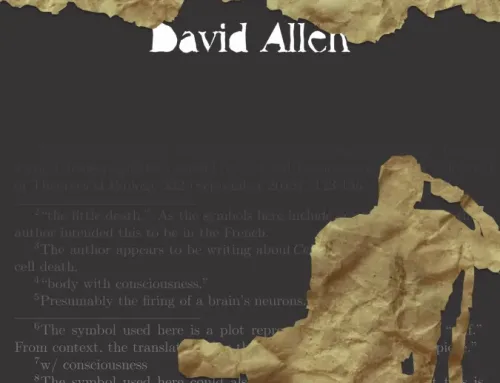On a particularly sunny, 71.5-degree day in April, Preston Alcott successfully invented the technology to speed up time.
Preston had been obsessed with the idea of time—more specifically, one’s perception of its passage—since he was a young boy. Growing up, his family had relatively little money. His father, working two to three jobs at any given point during Preston’s adolescence, was rarely present. Preston’s mother flitted between different income streams like a paranoid bee who was told she had to help support the hive.
One of Preston’s Mom’s jobs was working Saturdays as secretary to the pastor of a Lutheran church about 20 minutes from the Alcott’s home. The Alcotts were not Lutheran, and Preston had no idea how his mom got the job. All he knew was that since his father was also working (his third job) on Saturdays, Preston and his sister were obliged to accompany their mother to the Church.
While she worked, they were given free rein of a large gym, replete with a stage and a corner area that seemed to serve as both a mini-library and a play area for babies. Preston and his sister were too old for all of the toys in the library play corner. And, though Preston was allowed to bring one of his Lego inventions (and his sister her sketch pad), they were always bored out of their minds.
Perhaps it was due to the fact that their mom wasn’t allowed to turn on the heat in the gym. (His mom must have only had the job during the winter—Preston could not recall once being hot, or warm even, in that space.) Maybe the cold was partially to blame for the fact that time seemed slowed while they were there. But, whatever the reason, every Saturday at the Lutheran church felt like a week.
Sometimes, to pass the time, they’d play individually—Preston piloting his improbable Lego airship over the stage and his sister sketching on the carpet in the corner. Sometimes, they’d invent games. Once, at the free-throw line, they pretended they were falling down a bottomless pit. They acted as though it was hard to hear each other for the wind, and they would “swim” to each other through the air to imitate having tea. (When one falls down a bottomless pit, one finds objects also falling down that pit, apparently. Sometimes, it’s hot tea.)
Once, most notably, they pretended they could speed up time. They did everything as quickly as possible, as in fast forward. They spoke as quickly as possible. Preston’s sister corrected his speech, instructing him to use a higher voice like Alvin and the Chipmunks. It’s like when the record player used to be on the wrong setting, she explained. When sound moves faster, it’s higher. She was older than Preston, however, and he couldn’t recall the record player being on the wrong setting, but he took her word for it.
The positive effect of moving faster was that, for once, they weren’t cold. The negative effect was that completing everything in double time meant that they had effectively compressed the activity, leaving even more time for mind-numbing boredom. Falling down a bottomless pit, while cold, at least takes time.
Preston couldn’t say why, but this experience stuck with him. And while his sister went on to eventually study actuarial sciences (out of a loathing for poverty, perhaps), Preston could since only recall wanting to be one thing—an inventor. More specifically, he knew he wanted to make their game real and find a way to contract time.
For the longest time, however, it felt as though he was only successful in creating a bottomless pit—every small success in understanding the distortion of space-time gave way to a larger problem. Since no one would take him seriously were he to share his goal (particularly those people with capital), he was forced to make small “inventions” on the side to fund his obsession. And, unfortunately, as before, this bottomless pit was a game shared with his sister, who occasionally sent him money when his side projects weren’t enough to pay the heating bill.
Thanks to a children’s toy, however, his pit proved to have a bottom. The toy, a “hoverboard.” And, while Preston had a strong prejudice against the name (it did not “hover” in any meaningful way), he was inspired by its simple use of gyroscopes. It was so simple; in fact, he was embarrassed to have needed inspiration from such a poorly named object.
The last iteration of his “time box,” just prior to the gyroscopes, appeared to have worked as it should. The temporal stabilization field was limited to precisely the small tungsten box and its contents. And, when he opened the box, the clock inside was behind its twin that was kept just outside of the box. And, despite having only run the test at a 1% speedup, the difference was enough to discount any inconsistencies in the two timepieces.
He could remember the feeling when he first started the test—flush, nervous, his holey lab sweater suddenly feeling oppressive. Excitement, it would seem, was also a way to combat a cold lab.
He could also remember the feeling when he first saw the box rip a hole in his workbench—there was a bit less excitement. The experiment was brought to an early termination as the box fell to the ground, disconnecting the box’s field stabilization model from its internal power source, which, in turn, cut its wireless connection to the external temporal speed unit, triggering its failsafe.
Preston, having a strict definition of “success,” marked the experiment as failed despite the discrepancy in the timepieces. But, undeterred by the word “failure” in his notebook, he didn’t care that his workbench was ruined—the essentials of his experiment had worked. He ran to his chalkboard, wiped it (relatively) clean with his sweater’s sleeve, and wrote a formula for temporal shearing—a formula he should have thought of before testing.
It should have been obvious, he thought. The box’s temporal field shears space-time around it. When in contact with something like a table, say, this looks like ripping a hole in said table. So, Preston had to come up with a way to limit this shearing. Or, at least, to keep it from interacting with important things like tables and floors.
It wasn’t until more than a month later that he would be granted inspiration. He had been walking the dogs to help pay for his ever-increasing tungsten budget when one of the dogs, Crick, tried to chase an adolescent on their hoverboard.
Until this point, Preston had never posted anything about his work online. He had never even explained the nature of his work to his sister, who had, despite her ignorance, funded a large portion of it. But, with his new inspiration on the back of an almost success, Preston couldn’t help but post about his imminent success to an online forum.
Irrespective of his anonymity on the forum, Preston received a call the next day from a woman claiming to work for the government. Her first question was one Preston had no idea how to answer: What was his plan for his technology? Preston had never considered the application. He only knew he would do whatever it took to make the technology a success. So he took almost no time to answer “yes” when she asked her second question: Would he be interested in (lots) of government funding should he be able to demo his technology successfully?
Preston was excited to have witnesses to his first successful experiment, so he scheduled a demonstration for a time in April, by which he knew he would have his new tungsten time-box ready.
So, he built a slightly larger tungsten box now equipped with gyroscopes and a better connection between the field stabilization module and the internal power source. The gyroscopes allowed him to balance the box on a single point, limiting its contact with the concrete floor and (hopefully) limiting the spacetime shearing with solid objects.
Regretfully, Preston didn’t have enough information on the concrete mixture used to make the garage floor. But, despite his malaise when working with inexact data, he did his best to calculate the temporal shearing vector field and simulate its effect on the concrete. At best, spinning the box on its point would offset the effect and there would be no damage. At worse, it would create a dime-sized hole in the floor at a 5-minute time dilation.
To be sure, and to spare writing “failure” in his book once more, he ran his calculations 17 times before he was satisfied that he would not destroy his garage in front of a government representative. With confidence came a desire for another test before his guest would arrive. But Preston decided he would wait to experience his first success with someone else. And, with money he couldn’t (yet) spare, he ran to the store to buy a bottle marked “Champagne” (and not “Sparkling Wine”) along with 2 Champagne flutes.
Preston hadn’t considered needing 12 Champagne flutes, two more buckets of ice (with their respective bottles), or that it wouldn’t even be the lady on the phone who would come to verify his technology. When he greeted the 11 men at his door, however, he quickly did the estimations in his head. Even if he were to abstain, he only had enough champagne for about five guests, and 3 of them would have to drink from coffee mugs.
Despite his surprise, Preston held onto his anticipation as he led the 11 men to the garage. Also, he had decided he would save the Champagne for when they left, perhaps sharing it with his sister if she could find some free time to visit.
Preston presented his time box. He explained that time would run at a normal rate inside the box during the experiment, but outside of the box (the rest of the universe, in fact), they would experience time sped up. The idea was to, eventually, build a time box large enough for a man so that he could effectively travel into the future as the universe sped up around him.
He showed the men the two timepieces, placed one in the tungsten box, and explained that he would run a 30% speed-up for 30 seconds. At that last point, however, James, the only man who actually spoke during the entire event (and the only one not in government uniform), made a request: a 47.6% speedup over 52 minutes, rather.
Preston initially found the request bizarre but immediately understood once explained. It would be easy for a charlatan to fake such a demonstration with a planned time difference. It would be nearly impossible, however, to account for such random parameters should he be a fraud. A fraud, Preston was not. He had no problem agreeing to the new parameters.
Preston entered 47.6 and 00:00:52:00:00 into the temporal speed unit and hit the register button. The other men crowded around him as he waited for the sync light to turn green—indicating a proper connection with the time box. Preston requested space as he moved to the box itself, spinning it on its point. He went back to the temporal speed unit where the men, once more, crowded around as he waited for the spin light to turn green—indicating that the box was now spinning at an optimal speed to offset temporal shearing at the point.
It turned green, and Preston turned towards James, motioning towards the large button marked “GO.”
“Would you like to do the honor?”
Preston never considered the universe becoming a vastly hotter, more ionized place because, of course, Preston had never considered the ramifications a speed increase would have on molecular energy. It was of no consequence. A 47.6% increase in molecular speed, leading to a temperature increase from 71.5∘F to 697.4∘F, ensured that such things would never be considered.
The tungsten box, with a melting point of 6,192°F, survived.



Leave A Comment
You must be logged in to post a comment.